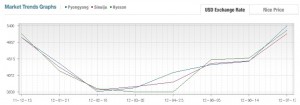It is getting harder to know specific information about the DPRK’s mobile phone network…such as how many subscribers have signed up or how revenues/profits are doing.
In December 2011 Orascom Telecom finalized a demerger and the KoryoLink portfolio (the DPRK’s 3G mobile phone network) was transferred to a new holding company, Orascom Telecom Media and Technology Holding S.A.E. (OTMT).
According to the Orascom Q1 2012 shareholder report (p15):
Under the terms of the VimpelCom transaction, VimpelCom, Weather II and OTH agreed on a demerger plan (the Demerger”) pursuant to which the Company‟s investments in certain telecom, media and technology assets (the “SpinOff Assets”), which were not intended to form part of the VimpelCom business going forward, would be transferred to a new company, Orascom Telecom Media and Technology Holding S.A.E. (“OTMT”). The Demerger was performed in accordance with the guidelines of the Egyptian Financial Supervisory Authority and in particular decree no. 124 of 2010 and was completed in December 2011. The split of OTH shares by the way of the Demerger resulted in OTH shareholders holding the same percentage interest in OTMT as they held in the Company. The Demerger plan was initially approved in a shareholders meeting dated 14 April 2011 and subsequently on 23 October 2011. Approval from the Egyptian Financial Supervisory Authority was received in December 2011.
As a result of the Demerger, during November and December 2011, ownership of the following Spin-Off Assets was transferred from the Company to OTMT:
[…]
75% ownership in CHEO Technology Joint Venture Company, together with all other assets and businesses located in
North Korea;95% ownership in Orabank NK;
[…]
Other than the reference above, the Q1 report does not mention KoryoLink or even the DPRK. As you would expect, KoryoLink is not mentioned in Orascom’s Q2 2012 Shareholder Report either.
OTMT (the new holding company) has a web page, however it contains remarkably little information. Here is what it has to say about KoryoLink:
Koryolink
A joint venture between OTH [Orascom Telecom Holdings] and the state-owned KPTC [Korea Post and Telecommunications Company] and included as part of the assets held by OTMT following the demerger. OTMT holds, a 75% stake in [Cheo Technology Joint Venture Company] with KPTC. The company is North Korea’s only 3G Mobile operator. By June 2011, Koryolink’s network covered more than 75% of North Korea’s population (estimated at 24.5 million).
Being the first company of its kind and scale in North Korea, koryolink established many precedents; a first of its kind call center to provide customer service; a launch announcement in major newspapers and on radio despite almost non-existent marketing and advertising industries; and the implementation of a koryolink advertising billboard, the first of its kind in Pyongyang.
KPTC is the “Korea Post and Telecommunications Company” which is nominally controlled by the DPRK’s Ministry of Post and Telecommunications.
This OTMT page shows five financial reports for the year, however, only one of them is in English (an audit by Deloitte in June 2012). All the other reports are in Arabic. The audit report includes aggregate financial information from “CHEO Technology (KoryoLink)”; however, it does not contain any detailed company information. Hopefully this will change in the future.
The OTMT web page does not mention OraBank at all. According to this organization chart, however, it appears to be held by a separate holding company under the OTMT umbrella, the Oracap Holding Co./Oracap Far East Ltd. I have not been able to find out much more than that.
Additional information welcome.

